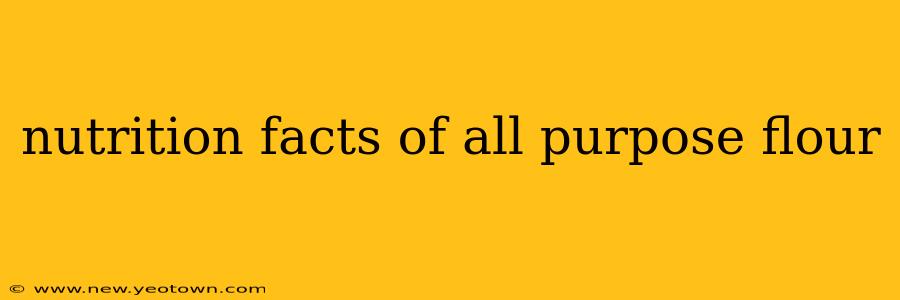Unlocking the Nutritional Secrets of All-Purpose Flour: A Baker's Deep Dive
All-purpose flour, the workhorse of countless kitchens, is more than just a baking ingredient; it's a staple with its own unique nutritional profile. But what exactly is in that seemingly simple bag? Let's delve into the nutritional facts of all-purpose flour and uncover some interesting insights that might surprise even seasoned bakers.
Imagine this: You’re standing in the baking aisle, a bag of all-purpose flour in your hand. The label boasts a simple list of ingredients – usually just "enriched bleached wheat flour" and perhaps some added vitamins and minerals. But behind this simplicity lies a complex nutritional story, one that involves carbohydrates, proteins, and even a bit of fiber. This journey will uncover the details behind those seemingly simple facts.
What are the basic nutritional facts of all-purpose flour?
A typical one-cup serving (120g) of all-purpose flour provides approximately:
- Calories: Around 455
- Carbohydrates: Approximately 95g, mostly in the form of starch.
- Protein: Roughly 13g, a decent source compared to other refined grains.
- Fat: Minimal, usually less than 1g.
- Fiber: Relatively low, around 3g per cup.
- Vitamins and Minerals: Enriched flour often contains added iron, thiamin (vitamin B1), riboflavin (vitamin B2), niacin (vitamin B3), and folic acid.
It's important to remember that these figures can vary slightly depending on the brand and type of all-purpose flour. Some flours may be unbleached, which can subtly alter the nutritional content.
Is all-purpose flour a good source of protein?
While not a primary protein source, all-purpose flour does contribute a reasonable amount of protein to your diet. The 13g per cup is a modest contribution, especially when considering the overall caloric content. This protein is valuable for building and repairing tissues, although it's not as complete as protein found in meat or legumes.
Does all-purpose flour contain fiber?
Yes, all-purpose flour does contain fiber, although the amount is relatively low. The approximately 3g of fiber per cup is a small contribution to your daily fiber intake. Whole wheat flour, on the other hand, boasts a significantly higher fiber content. The fiber in all-purpose flour primarily comes from the bran layer of the wheat kernel, which is partially removed during processing. This explains the difference in fiber content between all-purpose flour and its whole-wheat counterpart.
What vitamins and minerals are in all-purpose flour?
Modern milling processes often enrich all-purpose flour with essential vitamins and minerals. These additions help replenish nutrients that are lost during the refining process. The most commonly added vitamins are thiamin, riboflavin, niacin, and folic acid— all crucial for various bodily functions. Iron is also frequently added, contributing to red blood cell production and oxygen transport.
How does all-purpose flour compare nutritionally to other flours?
All-purpose flour sits somewhere in the middle of the nutritional spectrum for flours. Whole wheat flour significantly surpasses it in fiber content and boasts a higher concentration of several vitamins and minerals. However, all-purpose flour is often preferred for its texture and baking properties. Other specialty flours, like almond flour or coconut flour, have unique nutritional profiles, each with their own set of advantages and disadvantages.
Conclusion: All-purpose flour – A balanced perspective
All-purpose flour isn't a nutritional powerhouse, but it's a practical and versatile baking staple. Understanding its nutritional profile allows for informed choices in the kitchen. Remember to balance your all-purpose flour consumption with other nutritious foods, and don’t hesitate to explore other flour options to diversify your dietary intake. Choosing whole wheat flour occasionally, for instance, can boost your fiber and nutrient intake significantly. Baking should be enjoyable, and knowing the nuances of your ingredients makes the process all the more satisfying.

